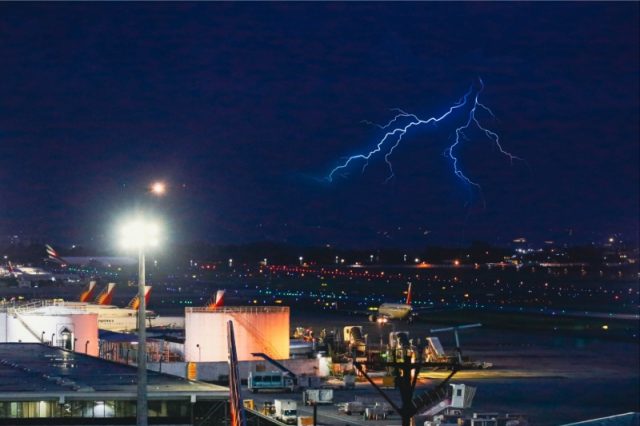The Manila International Airport Authority (MIAA) issued a lightning red alerts this week, thus suspending flight and ground operations at the airport.
In a statement on May 25, MIAA Officer-in-Charge Bryan Co explained that these alerts were issued for safety reasons under bad weather conditions.
“While aircraft at NAIA are protected from lightning strikes through the presence of lightning arresters, these alerts primarily prioritize the safety of people on the ground, which is of paramount importance for us as an airport operator,” Co said.
The Ninoy Aquino International Airport (NAIA), the premiere gateway of the country, is equipped with 20 lightning arresters and four lightning shelters to protect the numerous electrical and telecommunication facilities from lightning.
Strategically located in the ramp area, these devices capture and then direct lightning surges to the ground where they are absorbed.
Co also called for the public’s understanding and cooperation following the temporary suspension of their flights.
“We kindly ask for the cooperation and understanding of every passenger when ramp operations are suspended for safety reasons during a Lightning Red Alert,” he said.
The red and yellow lightning notices were recently being issued amid the looming threat of “Typhoon Mawar” (international name) to the country.
This will be named “Betty” once it enters the Philippine Area of Responsibility (PAR).
What do the alerts mean?
The MIAA Airport Ground Operations and Safety Division (AGOSD) is in charge of issuing lightning alerts to the public.
AGOSD implements two types of lightning alerts for the safety of people on the tarmac—red and yellow.
In 2022, a total of 439 lightning red and yellow alerts were issued due to bad weather. The interval for a red alert to downgrade to a yellow status is an average of 1 hour and two minutes.
Red Alert
At 6:49 p.m. on May 25, AGOSD announced a lightning red alert to air passengers and airport personnel, thus ordering all flight, ground and airport operations to stop.
This status was once again raised on Friday, May 26 at 1:25 p.m.
It is raised if intense lightning activity is within 9 kilometers of NAIA.
“The alert is a safety measure taken to prevent the untoward incident from happening when lightning [is] prevalent in the immediate area and may endanger personnel, passengers and even flight operations,” the advisory reads.
Here is the previous post from MIAA that listed the measures it performs to ensure the safety of all air personnel during intense lightning activity:
Yellow Alert
At 7:16 p.m. last Thursday, MIAA’s AGOSD lowered the previous red alert to a yellow warning system.
This means that “flight operations at NAIA have resumed.”
The latest red alert notice on Friday is yet to be lowered again as of writing. Airport operations thus are still suspended since early this afternoon.
The Lightning Activity System (LAS)
PAGASA is responsible for installing the Lightning Activity System (LAS) that determines the severity of lightning activities around the area.
Since 2012, NAIA has had a policy on lightning strikes in place to keep its employees safe.
In 2014, however, an employee got struck by a lightning bolt while working on the tarmac during a thunderstorm.
This incident prompted the NAIA to amend the policy in 2014 into the current Red Lightning Alert Scheme being imposed.
Years later, in 2022, MIAA enlisted the help of Earth Networks, a weather solutions provider, for an installation of a lightning early warning system.
According to the authority’s website, this system includes “lightning warning systems with audible and visual alerts that activate when lightning approaches a pre-defined radius around the aerodrome.”
“It also features a countdown clock displaying the alert status and time to an all-clear, facilitating the easy suspension and resumption of ramp activities,” MIAA explained
“Consequently, the real-time information provided by Earth Networks assists MIAA in mitigating the impact of lightning strikes on airport operations,” the agency further said.








